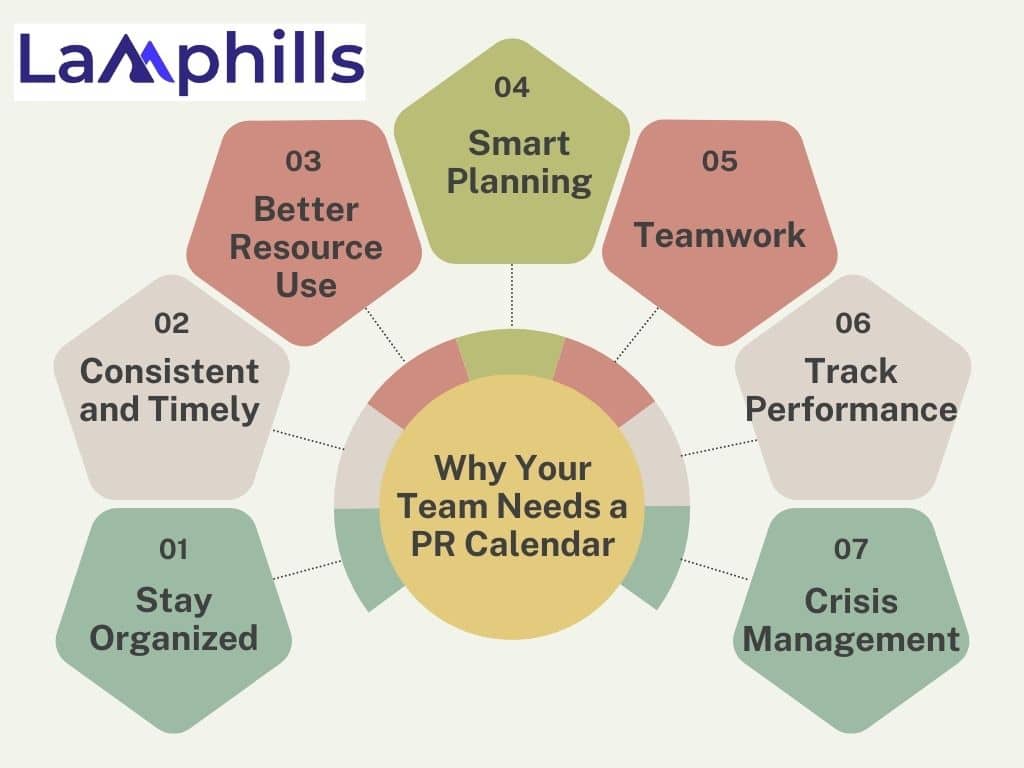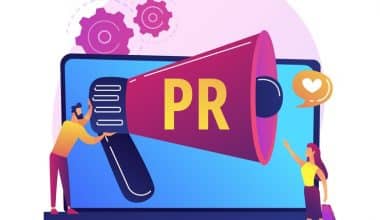A PR calendar helps make sure everyone is informed and can handle both scheduled and unexpected events. Managing a brand’s reputation well is a big job. Strong brands aren’t created by one-time flashy events but by careful, long-term efforts. This requires planning and commitment, which is possible when everyone follows a detailed PR schedule that matches the company’s goals.
I remember the day my PR strategy improved drastically. It was a rainy Tuesday, and I was sitting in my office, overwhelmed by too many tasks and deadlines. Despite my hard work, our PR campaigns weren’t working well, and the results were disappointing. I needed a breakthrough, something that would change how we managed our public relations. That’s when I discovered the PR calendar template. Little did I know, this would lead to over 400% better results.
Let me show you how you can achieve the same success with the perfect PR calendar template.
Key Points
- A PR calendar is more than just a schedule of events; it organizes all your PR activities in one place. It helps you plan and execute campaigns precisely, ensuring no opportunity is missed.
- Here’s the main point, a PR calendar will greatly increase the chances that your clients are featured in important print, online, and social media conversations their customers follow all year.
- A PR calendar helps your PR strategy by scheduling monthly tasks in advance, keeping you and your team prepared ahead of time, instead of scrambling to react to unexpected holidays, national days, or seasonal themes.
- To use a PR calendar template effectively, include these elements: Title and brief description of the activity, Label or tag to keep the calendar organized and easy to search, Timeline with key dates for execution and publication, Objectives that align with overall business goals, Details about the target audience, Key metrics to measure success, and so on.
What is a PR Calendar
A PR calendar is more than just a schedule of events; it organizes all your PR activities in one place. It helps you plan and execute campaigns precisely, ensuring no opportunity is missed. From press releases and media pitches to social media updates and event planning, a well-made PR calendar keeps everything on track.
PR experts and agencies use this tool to organize public relations plans and actions. It’s a schedule for all PR tasks, such as press releases, events, interviews, and crisis management. A PR calendar helps the marketing strategy by aligning PR efforts with goals, making tasks easier to carry out, ensuring team transparency, and allowing stakeholders to monitor results.
As soon as I started using a PR calendar, our workflow improved immediately. Our campaigns became timely, relevant, and much more effective.
Why Your Team Needs a PR Calendar
Here’s the main point, a PR calendar will greatly increase the chances that your clients are featured in important print, online, and social media conversations their customers follow all year.
A PR calendar helps your PR strategy by scheduling monthly tasks in advance, keeping you and your team prepared ahead of time, instead of scrambling to react to unexpected holidays, national days, or seasonal themes.
It helps you focus on the best opportunities for each client, guiding your team through many story ideas, news angles, and media requests throughout the year. During slower times, it highlights upcoming opportunities that your account managers should start planning for.
Other significant reasons include:

Aligning Public Relations With Other Business Activities
Think of the various calendars in your Google Calendar as different parts of your PR and marketing strategy. Each one gives a unique view, but together, they form the complete picture.
Your PR calendar should be the top layer, above your business, content, and marketing calendars. It shows how you’ll use publicity to boost your marketing messages. By viewing all these calendars together, you can see how public relations connects with your other business and marketing efforts.
Creating a PR calendar is crucial for any team wanting to improve their public relations strategy. Here are seven simple reasons why your team needs a PR calendar:
Stay Organized
A PR calendar helps your team stay organized and gives a clear plan for PR activities. It makes sure everyone knows what’s happening and can easily keep track of events, deadlines, and campaigns.
Consistent and Timely
With a PR calendar, your team can send out messages consistently and on time. It helps avoid last-minute rushes and ensures your PR efforts match important dates and events, making them more effective.
Better Resource Use
A PR calendar helps your team use resources better. By planning ahead, you can make sure you have the right people, budget, and materials for each campaign, avoiding problems and waste.
Smart Planning
Using a PR calendar lets your team plan PR activities in line with business goals. It helps spot key chances for media coverage, product launches, and other important events that can boost your brand.
Teamwork
A shared PR calendar improves teamwork. It allows for smooth communication and coordination, making sure everyone knows their roles and can work together to succeed in PR campaigns.
Track Performance
A PR calendar helps track how well your PR efforts are doing. By keeping records of past activities and results, your team can see what worked and what didn’t, helping you improve your PR strategy over time.
Crisis Management
Having a PR calendar helps your team prepare for potential crises. By regularly planning and scheduling PR activities, your team can quickly adjust and respond to unexpected events, keeping your brand’s image positive even in tough times.
Easier Internal & External Collaboration
Finally, working in public relations means you are responsible to many people, including journalists, publishers, colleagues, and freelancers.
A PR calendar can be shared with everyone involved in the projects. It helps in coordinating efforts and ensures you meet deadlines without missing opportunities for coverage.
A PR Calendar Can Make Your Team’s Monthly Tasks Easier to Manage
It’s especially useful when combined with PR software. With these tools, the PR calendar helps your team know when to start tasks like creating media contact lists, writing email pitches, and setting up online newsrooms.
Using a PR calendar with PR automation software sets up a clear monthly schedule that helps your team follow simple, repeatable steps. This saves you time on managing projects and lets you focus on important tasks like finding new clients, hiring, and planning for revenue.
In summary, using a PR calendar helps your team stay organized, plan better, and work more effectively in public relations.
Elements of an Effective PR Calendar Template
To use a PR calendar template effectively, include these elements:
- Title and brief description of the activity
- Label or tag to keep the calendar organized and easy to search
- Timeline with key dates for execution and publication
- Objectives that align with overall business goals
- Details about the target audience
- Distribution channels like social media, media outlets, and influencers
- Responsible team members and approval steps
- Allocated budget
- Key metrics to measure success
1. Title and Brief Description of the Activity
This is a key part of a good PR calendar template. The title gives a clear and simple name for the activity, making it easy to recognize quickly. The brief description gives a quick overview of the activity, helping team members understand it without needing detailed documents. This ensures everyone knows what each activity is about and its purpose. Including this information helps organize and prioritize tasks effectively in the PR calendar.
2. Label or tag to keep the calendar organized and easy to search
Using labels or tags is crucial for organizing and searching activities in a PR calendar. By giving each activity a specific label or tag, team members can quickly find and sort events, making the calendar easier to use. This helps sort activities based on different criteria, like campaign type or target audience. Labels and tags also help identify related tasks and ensure everything is noticed. Overall, they make planning more efficient and improve the management of PR activities.
3. Timeline with key dates for execution and publication
A good PR calendar template should have a clear schedule with important dates for carrying out and releasing information. Start by marking important events and deadlines like product launches, industry conferences, and holidays, to organize your PR tasks. Next, set specific dates for writing, checking, and finishing press releases and other PR documents. Then, plan when to send these materials out to ensure they reach the media and important people on time. Lastly, set dates to check how much attention and interaction you get, so you can change your plans if necessary.
4. Objectives that align with overall business goals
Goals that match the main business aims are key to a good PR calendar template. These goals form the basis for all PR tasks, making sure each one helps the larger business targets. By having these goals, companies can check how well their PR is doing by looking at real results, like higher sales or better brand awareness. Matching PR goals with business targets also helps decide which PR tasks to focus on, choosing those that have the most impact. This way, the PR approach is clear and directly aids the company’s success.
5. Details about the target audience
Understanding your audience is essential for a successful PR calendar. This means identifying who they are, their age, interests, and preferences. Knowing this helps create messages that connect with them and keeps communications relevant and engaging. Including audience details in the PR calendar aids in planning the best times and channels to reach them. Regular updates ensure the PR strategy stays in tune with their changing needs and behaviors.
6. Distribution channels like social media, media outlets, and influencers
Social media, media outlets, and influencers are essential parts of a good PR calendar. Social media lets you share your message quickly with many people and get immediate responses. Media outlets like newspapers, magazines, and online news sites give your message credibility and reach specific audiences. Influencers can boost your message by sharing it with their followers, adding a personal and trustworthy touch. Using these channels in your PR calendar ensures you reach your audience effectively and strategically.
7. Responsible team members and approval steps
A good PR calendar template clearly shows each team member’s job, making sure everyone knows what they need to do. Assign specific tasks like writing, editing, and sharing to certain people to make the work go smoothly. Include steps for approval, noting who must review and approve PR materials at each stage. This ensures all content is high-quality and matches the company’s message. By having clear roles and approval steps, PR activities stay organized and efficient, reducing mistakes and delays.
8. Allocated budget
The budget is a key part of a good PR calendar. It shows how much money you have for each PR activity. By setting a budget, you can plan and prioritize your tasks better and avoid spending too much. It also helps in predicting and managing costs for press releases, events, and other PR materials. Regularly checking the budget helps make sure the PR campaign stays on track and within limits.
9. Key metrics to measure success
To measure success in a PR calendar template, track key metrics like media coverage, which counts the number and quality of press mentions. Measure social media engagement by looking at likes, shares, and comments to see how the audience interacts. Use website traffic analytics to identify spikes in visits after PR activities, indicating effective outreach. Monitor lead generation metrics to see how many new inquiries or sales leads come from PR efforts. Finally, use sentiment analysis to understand the overall public perception and tone of the received coverage.
These components will make your PR calendar useful for all team members. Choose a tool that allows easy calendar visualization for everyone, from strategic planners to those executing the tasks.
How To Create & Manage A PR Calendar
Experience clear communication and organization in your team using a PR Calendar. Here’s how to begin:
1. Choose Your Format
If you don’t already use a calendar tool for your business, the first step is to choose one that fits all your PR needs. Options include a spreadsheet, digital calendar, or editorial calendar tool. Choose what fits your team’s needs best.
There are some pros and cons for each option, so take the time to consider your own team’s needs. There are some points to consider when choosing a calendar tool:
- Easy online access: Ensure it’s shareable and mobile-friendly so you and your team can access it anywhere.
- Collaborative features: Since PR campaigns involve many people and tasks, choose a tool that allows multiple users to access and edit it.
- API (Application Programming Interface) compatibility: Make sure the tool can sync with your emails, project management software, or other applications.
Many calendar tools are free or part of larger office packages. Just make sure it suits your business needs.
2. Set Goals and Key Metrics

Image by Waewkidja on Freepik
What do you want to achieve with your PR strategy, and how will you track your success? These are important questions to ask when making a PR calendar because they help you meet your goals.
Consider what you want to accomplish and how you’ll measure it, like tracking website visits or generating leads. Ensure each calendar entry connects to these goals and measurements.
You can also match your goals and measurements with new and popular PR strategies you want to try. Digital storytelling and social listening are popular in PR now, but you need to see if they improve your results before knowing if they’ll work for you.
Many online calendars have categorizing systems that let you tag or label different events and launches with their related goals and metrics.
3. Add important dates.
Effective PR planning includes taking advantage of external events and holidays. This can be seasonal events, major holidays, or the end of the financial year for various businesses.
Include key dates from your own PR schedule, such as product launches and networking events. Your PR calendar should cover at least the next two years, allowing you to plan campaigns well in advance. PR requires both long-term strategies and quick, timely actions.
4. Choose Your Content Type
List the type of content you need, such as press releases, blog posts, or social media updates. Create a content schedule that supports your goals.
Once you choose where to keep your PR calendar, start planning your campaigns and processes. Begin by figuring out what kinds of content you need to create and share to boost your content and PR efforts.
If it’s about public relations, you should schedule it on a calendar. It helps to organize different types of content into separate categories in the tool you are using.
5. List Activities and Channels
Now, list the activities you plan to do over the next year, including the staff involved and the channels you’ll use. Include in-person events, online channels, email promotions, and press releases.
As mentioned earlier, label activities based on their specific goals or campaigns. This will help you and your team easily filter the calendar to focus on specific events and tasks.
Also, think about the global impact of your PR efforts. Should blog posts be expanded to target regions where your customers are located, like finding opportunities on websites with .qa domains? Make sure to include this when scheduling activities to reach the right audience.
6. Set Your Posting Schedule
Next, decide how often you want to post content, including both the content you create and the content others make about you. Consider several important aspects when planning this.
Regardless of your team’s size, set realistic deadlines. This will also allow you some free time to react to urgent trends and events as they arise. Also, consider which seasonal trends or campaigns will be most effective.
You should try to keep your brand in the thoughts of your audience as often as you can. However, it’s also good to spread out your content during less busy times.
Once you understand the limits you have, you can plan how often to share your content, like making videos every month, writing blog posts every week, and posting on social media every day.
7. Brainstorm & Add Content Ideas

Image by tirachardz on Freepik
Once you’ve set up your calendar’s format and schedule, you can begin thinking of content and public relations ideas to fill the empty spots. Try to align your ideas with relevant themes or seasonal trends whenever you can.5. Add Content that is Specific to Your Industry
PR calendars differ depending on the industry. Content that one business needs might be irrelevant for another.
To make your calendar useful, focus on industry-specific content like:
- Industry conference dates
- Awareness months
- National days
- Important seasonal events
- Industry awards
- Personal speaking opportunities
- Community events
8. Assign Responsibilities
For each important task, campaign, or event, the PR calendar should list who is responsible for it.
Delegate tasks to team members. Ensure everyone knows their roles and deadlines to keep the calendar on track.
9. Include Contact Information
To keep things running smoothly, add the contact details for everyone involved. This includes reporters, freelancers, designers, and anyone else you need to communicate with.
10. Keep Things Organized and Monitor Progress
Regularly check your calendar to track progress. Adjust plans as needed to stay on track and address any issues promptly.
To use your new calendar effectively, make sure to check it every day when you start work. This simple habit can make a big difference.
Here are some tips to manage your calendar:
- Use color coding for easy and quick reference.
- Set aside time each week to update the calendar.
- Discuss the calendar during team meetings.
If you’re using a PR Calendar tool, you can link it to your WordPress blog, social media profiles, and email marketing tool. This allows you to plan, draft, and schedule content all in one place.
Using specialized tools also helps break down projects into tasks using templates, which is something you might not get with a basic spreadsheet.
Creating Your PR Calendar Template

To create your PR calendar template, you can use tools like Excel, Google Sheets, or specialized PR software. Here’s a step-by-step guide:
1. Set Up Your Template: Start by setting up the framework of your template. Create sections for the annual overview, monthly breakdown, weekly/daily tasks, content themes, media outreach, and metrics.
2. Populate Key Dates: Fill your template with key dates and events. Include industry-specific dates, holidays, and any other relevant events.
3. Plan Content Themes: Identify content themes for each month. Align these themes with your overall PR strategy and objectives.
4. Schedule Media Outreach: Outline your media outreach plan, including pitch dates, follow-up schedules, and targeted media lists.
5. Set Goals and Metrics: Define clear goals and metrics for each campaign. Include these in your template to track progress and measure success.
Personal Experience: From Overwhelmed to Organized
Before I started using a PR calendar, my approach was scattered and reactive. I was constantly rushing to meet deadlines and often missed valuable opportunities. But once I implemented the PR calendar template, everything changed. I became more organized, proactive, and strategic in my approach. Our PR campaigns started gaining traction, and the results were astounding. We saw a 400% increase in media coverage, social media engagement, and overall brand visibility. It was a game-changer.
Examples of Marketing Calendar Templates
There are many ways to adjust these templates. Make sure to balance the detail you need with the time it takes to keep the calendar updated. You don’t need to include everything, choose what works best for your team and your PR goals.
PR and Communications Calendar Template
This marketing calendar helps plan how to communicate with customers, including emails, newsletters, press releases, and in-app messages. Different icons show the team how the messages are spread out over the month.
Click on the download button to download.
Event Calendar Template
This calendar helps you plan in-person or online events for the year. Use the daily view to schedule activities for the event day. You can copy the daily calendar to use it for each event.
Click on the download button to download.
Social Media Calendar Template
Use this template to plan your social media posts for each day and platform. There are seven sections—one for each day of the week. Customize the details based on the platforms you use.
Click on the download button to download.
Content Marketing Calendar Template
This calendar helps content marketers plan their work. Use different colors to show different types of content, like blog posts, customer stories, and white papers. You can copy, change, and move the colored boxes to fit your team’s needs.
Click on the download button to download.
Tips for Maximizing Results with Your PR Calendar
1. Stay Consistent: Consistency is key. Stick to your schedule and ensure every task is completed on time.
2. Be Flexible: While consistency is important, so is flexibility. Be ready to adjust your plans to accommodate unexpected opportunities or challenges.
3. Collaborate: Involve your team in the planning process. Collaboration ensures everyone is on the same page and working towards the same goals.
4. Review and Adjust: Regularly review your PR calendar and make adjustments based on the results. This helps optimize your strategy and improve outcomes.
Summary
Using a PR calendar template changed how I handle public relations. It added order, organization, and planning to our campaigns, resulting in great success. If you want to improve your PR efforts and get big results, I strongly suggest making and using a PR calendar template. It’s an easy yet effective tool that can greatly enhance your PR strategy.
By setting your goals, identifying key dates, planning your content, scheduling media outreach, and regularly reviewing your calendar, you can achieve similar success. Personalize your calendar to stay motivated and organized. Start today, and watch your PR efforts reach new heights.
What strategies have you found effective in your PR planning? Share your experiences in the comment section, and let’s continue to learn and grow together.
Bonus Answer to FAQs.
What is a publicity calendar?
It explains the media outreach tasks for the year and divides them into easy monthly plans. This ensures your team knows about important PR chances in advance. The best part is, once you create a yearly PR calendar for the team, you can reuse it every year as a PR calendar template.
What is a PR plan for the year?
A PR plan is a document that explains how you will communicate with your audience, customers, and stakeholders over time. Its goal isn’t just to create excitement for single events or anniversaries. Instead, it aims to provide continuous results that improve your brand’s reputation long-term.
What are the key elements of a PR plan?
The 4 key parts of a PR campaign you need to focus on are goals, objectives, strategies, and tactics. Knowing the differences between these will help you plan and organize your campaign better. Goals are what you want to achieve, not the specific steps or actions you will take to get there.
What should be included in a PR calendar?
PR calendars usually have:
- Important dates and events: This includes things like product launches, industry events, holidays, and other dates important to your PR activities.
- Assigned people: For each key task, campaign, or event, the PR calendar should clearly state who is in charge of getting it done.
Related Articles:
- Sports Press Release: Best 2024 Practices & How to Write Guide
- How to Write a PR Report: Structure,& Expert Tips
- Press Release Examples to Inspire You in 2024 (+ Expert Tips & Templates)






